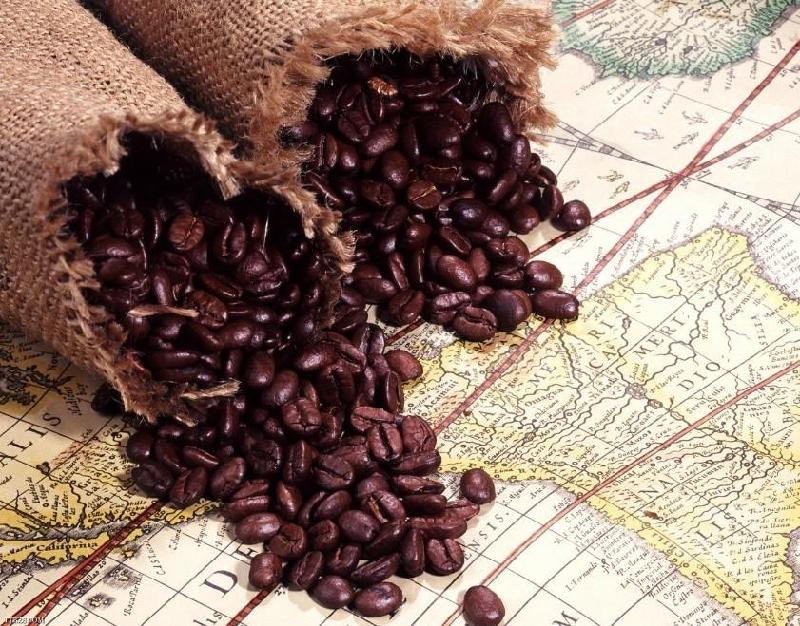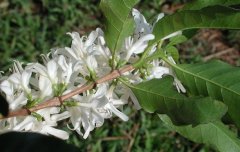The basic knowledge of Coffee planting the basic knowledge of Coffee trees

The origin of the coffee tree is Ethiopia in Africa. In botany, coffee trees belong to the long green trees of the subgenus Rubiaceae, and coffee beans, commonly known as coffee beans, are actually the seeds of the fruit of coffee trees, just because they are shaped like beans, so they are called coffee beans.
Climate is the decisive factor for coffee cultivation. Coffee trees are only suitable for growing in the tropics or subtropics, so the zone between latitude 25 degrees south and north is the most suitable for growing coffee. This coffee production zone is generally referred to as "coffee belt" or "coffee area".
White flowers, red fruit. Evergreen shrubs of the genus Coffee, belonging to the Rubiaceae family in botany, can reach a height of up to 10 meters, while artificial growers are only two to four meters tall because of pruning. Coffee will probably seed in three to four years, and the yield will decrease after 20 to 25 years, but some coffee trees will still bear fruit after a hundred years of life.
The branches of the coffee tree grow opposite and grow horizontally or drooping, while the leaves of the coffee tree are opposite on the short-diameter branches. The two main species are Arabica (Coffee Arabica) and Robusta (Coffee Robusta). The leaves of Arabica are about 15 centimeters long. Robusta's leaves are long, soft oval or pointed, and bright green in color.
The origin of caffeine
The first flowering period of the coffee tree is about three years old. the white five-petal tube-shaped flowers are filled with a faint scent of jasmine and the inflorescences are arranged in dense clusters.
Flowers wither after two or three days of blooming and begin to bear fruit after a few months. The fruit is a drupe with a diameter of about 1.5cm. It turns green at first, then turns yellow gradually, and turns red when ripe. It is very similar to cherries, so it is called cherry coffee (Coffee Cherry). It can be harvested at this time.
Coffee fruit contains two seeds, namely coffee beans. The two beans are connected face to face with each other on one side of the plane. Each coffee bean has a thin outer film, which is called silver skin, and its outer layer is covered with a yellow outer skin, called endocarp.
The whole coffee bean is wrapped in sticky pulp to form the coffee pulp, which is soft and sweet, with the outermost shell.
Species of caffeine trees
At present, the most important coffee beans in the world mainly come from Arabica, Robasta and Liberia. these three varieties of coffee beans are the three original species of coffee trees, and the quality of coffee beans produced by other coffee trees is also higher than that of other coffee trees.
The output of Akabica beans accounts for 70% of the world's output; the world-famous Blue Mountain Coffee and Mocha Coffee are almost all Arabica species. The Robastian coffee tree, which originated in the Congo in Africa, accounts for about 20% to 30% of the world's production.
Refined method of caffeine
Coffee beans are the seeds in the coffee fruit, which are exposed to strong sunlight and are not removed until the shell is cracked. This method is called "non-washing" or "natural drying".
Another way is to put the coffee fruit in the sink, soak in water and soften and then remove the "washing" of the flesh. The washing refining process is to put the harvested coffee fruit in a sink and soak for 24 to 28 hours. In this way, only the ripe fruit will sink, while the immature fruit will float on the water, so that the ripe fruit can be selected.
After that, put it into the pulp removal machine, remove the skin and pulp, leaving only seeds. Then put the seeds in the fermentation tank for half a day to a day, so that the pulp residue on the seeds will fall off as a result of fermentation.
Finally, rinse with water, dry in the sun, and remove the seed coat with a sheller. This method has less sundries, and can pick out immature coffee beans, so the appearance and quality are better.
The non-washing operation procedure is relatively simple, as long as the program management is perfect, mature and high-quality coffee beans can be obtained. However, this way is easily affected by climate, and the proportion of incomplete beans is very high. In addition, coffee beans treated in this way often have an earthy taste and are not suitable for long-term preservation.
Baking and tasting
Since the Arabs discovered the coffee beans, the first way to eat them is to put the whole fruit of the coffee into the mouth and chew it to get its juice.
Later, they ground the coffee beans from the fruit and mixed them with animal fat as a physical supplement for caravans to trade far away.
After that, around 1000 AD, it was changed to the method of boiling raw beans into soup. It was not until the 13th century that the Arabs invented the method of roasting coffee beans, so that the charming aroma of coffee was completely pulled out, so that coffee was no longer just a pick-me-up, but a worldwide drink.
Generally speaking, according to the division of baking degree, the roughest can be divided into three stages: shallow stir-frying, medium stir-frying and deep frying. Coffee beans can cause subtle changes in taste and flavor due to different degrees of roasting.
Generally speaking, if the baking degree is shallow, the sour taste is heavier. With the deepening of the baking degree, the sour taste will gradually disappear, and the bitter taste will become more prominent. What kind of roasting degree can give birth to the most delicious coffee? In fact, the depth of baking must be based on the types, characteristics, brewing methods, usage and, most importantly, personal preferences, to determine the most appropriate baking degree.
Important Notice :
前街咖啡 FrontStreet Coffee has moved to new addredd:
FrontStreet Coffee Address: 315,Donghua East Road,GuangZhou
Tel:020 38364473
- Prev

High-definition pictures of coffee flowers appreciate the process of growing boutique coffee beans
Go to the coffee taste network to exchange beautiful coffee flowers: every early spring, milky flowers are covered with branches, set off by the vertical green leaves, more delicate and beautiful. Coffee flowers exude a strong aroma, do not have some amorous feelings, but the flowering period is very short. Several to dozens of flowers are clustered in the axils of leaves, and the second to fifth flowers are planted on a flower axis. The flowers are white and fragrant. The petals of medium and small seed species are generally 5.
- Next

Coffee beans roasting and roasting degree Introduction Coffee roasting has the following degrees
Roasting causes coffee to produce coffee oil, which is what gives coffee its rich aroma. The most outstanding characteristic of this fragrance is its volatility and its easy solubility in water. Therefore, people can smell the mellow smell of coffee beans, but also can pour it into the cup to taste. There are several degrees of coffee roasting: Light roasting Light aroma and high acidity are one of its characteristics
Related
- Beginners will see the "Coffee pull flower" guide!
- What is the difference between ice blog purified milk and ordinary milk coffee?
- Why is the Philippines the largest producer of crops in Liberia?
- For coffee extraction, should the fine powder be retained?
- How does extracted espresso fill pressed powder? How much strength does it take to press the powder?
- How to make jasmine cold extract coffee? Is the jasmine + latte good?
- Will this little toy really make the coffee taste better? How does Lily Drip affect coffee extraction?
- Will the action of slapping the filter cup also affect coffee extraction?
- What's the difference between powder-to-water ratio and powder-to-liquid ratio?
- What is the Ethiopian local species? What does it have to do with Heirloom native species?

